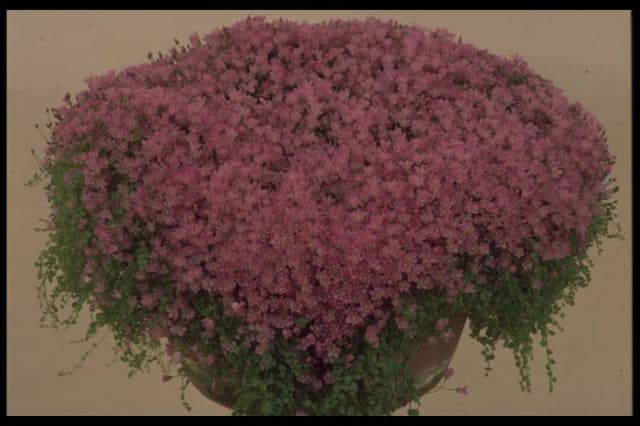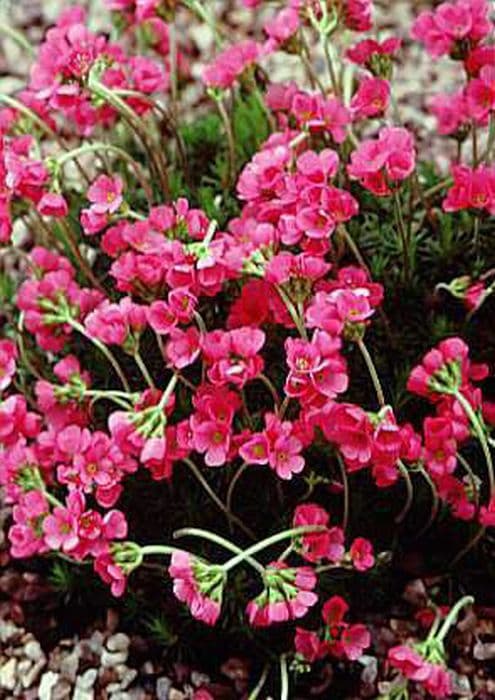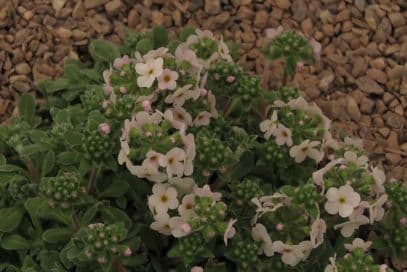Florist's Cyclamen Cyclamen persicum 'Halios Scarlet Red' (Halios Series)
ABOUT
The Cyclamen persicum 'Halios Scarlet Red', commonly known as Persian cyclamen, is a striking plant recognized for its vibrant, rich red blooms. The heart-shaped leaves feature a silver-marbled pattern over a dark green background, making a beautiful contrast with the vivid scarlet flowers that rise above on long, slender stems. This particular variety is noted for its large flowers that typically have a dramatic, swept-back appearance, resembling a flurry of butterfly wings dancing atop the foliage. The flower petals exhibit a slightly ruffled edge, adding to their ornamental charm. The blooms and foliage together create an impressive display of color and form.
About this plant
 Names
NamesFamily
Primulaceae
Synonyms
Persian Cyclamen, Florist's Cyclamen
Common names
Cyclamen persicum 'Halios Scarlet Red'
 Toxicity
ToxicityTo humans
The cyclamen is considered toxic to humans if ingested. The most toxic part is the tuber, which contains saponins that can cause symptoms if consumed such as gastrointestinal upset including nausea, vomiting, and diarrhea. In some cases, ingestion can also lead to more severe symptoms such as seizures or heart rhythm abnormalities, although such extreme reactions are rare. It's advisable to seek medical attention if any part of the cyclamen plant is ingested, particularly by children or vulnerable individuals.
To pets
The cyclamen is also toxic to pets, including dogs and cats. The tubers contain the highest concentration of toxins, particularly saponins, which can cause symptoms like vomiting, diarrhea, and salivation if ingested. In severe cases, ingestion can result in heart rhythm abnormalities, seizures, and even death. Therefore, it is important to keep cyclamen plants out of reach of pets and to consult a veterinarian immediately if you suspect your pet has ingested any part of the plant.
 Characteristics
CharacteristicsLife cycle
Perennials
Foliage type
Evergreen
Color of leaves
Green
Flower color
Scarlet Red
Height
6-9 inches (15-23 cm)
Spread
6-9 inches (15-23 cm)
Plant type
Bulb
Hardiness zones
9
Native area
Middle East
Benefits
 General Benefits
General Benefits- Ornamental Appeal: Cyclamen persicum 'Halios Scarlet Red' has vibrant red flowers that add a pop of color to gardens and indoor spaces.
- Compact Size: Its small stature makes it suitable for container gardening and small-space landscaping.
- Seasonal Interest: Blooming typically in late winter to early spring, it offers visual interest during a time when few other plants are flowering.
- Long Blooming Period: This variety of cyclamen has a prolonged blooming season, providing color for an extended time.
- Drought Tolerance: Once established, it has moderate drought tolerance, reducing the need for frequent watering.
- Attracts Pollinators: The flowers can attract bees, helping to pollinate other plants in the garden.
- Easy to Grow: It is known for being relatively easy to care for, which is ideal for novice gardeners or those with limited time.
- Versatility: It can be grown both indoors as a houseplant and outdoors in suitable climates, offering flexibility in use.
 Medical Properties
Medical PropertiesThis plant is not used for medical purposes.
 Air-purifying Qualities
Air-purifying QualitiesThis plant is not specifically known for air purifying qualities.
 Other Uses
Other Uses- As a natural clothes dye: The pigments in Cyclamen flowers can be used to dye fabrics with vibrant reds and pinks.
- In potpourri mixtures: Dried Cyclamen petals can be added to potpourri to impart color and a subtle fragrance.
- As a model in botanical illustration: Artists often use Cyclamen plants for practicing watercolor techniques due to their distinct shapes and vivid colors.
- As a decorative garnish: Cyclamen flowers, being non-toxic, can be used as a garnish on desserts and salads for an elegant presentation.
- In crafting eco-friendly confetti: Dried petals of the Cyclamen can be used as a biodegradable alternative to traditional paper confetti.
- In homemade scented sachets: The flowers and leaves of the Cyclamen can be dried and used in sachets to freshen up drawers and wardrobes.
- As a natural insect repellent: Some believe that the scent of Cyclamen can deter certain insects, so it might be used around the house for this purpose.
- In photography projects: Cyclamen flowers provide an interesting subject for macro photography due to their intricate patterns and striking colors.
- As educational tools: Cyclamen plants can be used to teach botany and horticulture, demonstrating plant anatomy and growth cycles.
- For color-themed landscaping: Cyclamen's vivid red flowers are ideal for creating a specific color palette in garden designs.
Interesting Facts
 Feng Shui
Feng ShuiThe Cyclamen is not used in Feng Shui practice.
 Zodiac Sign Compitability
Zodiac Sign CompitabilityThe Cyclamen is not used in astrology practice.
 Plant Symbolism
Plant Symbolism- Love and Devotion: Cyclamen is often associated with deep love and devotion, making it a common gift between lovers or close friends.
- Goodbye and Parting: The cyclamen's tendency to wither and go dormant conveys a message of goodbye or temporary separation, symbolizing a farewell but also the hope of a future reunion.
- Sincerity: The cyclamen's simple and elegant appearance is thought to represent sincerity in one's emotions and actions.
 Water
WaterCyclamen, commonly referred to by its genus name, should be watered thoroughly when the top inch of soil feels dry to the touch, usually every 7 to 10 days depending on environmental conditions. During active growth in cooler months, water with approximately 8-16 ounces, taking care not to wet the crown of the plant which can cause rot. Reduce watering frequency once the plant enters dormancy after flowering. Always provide good drainage and never let the plant sit in water as this can lead to root rot.
 Light
LightCyclamen thrives in bright, indirect light. Place it near a north or east-facing window where it can receive adequate but diffused sunlight. Direct summer sun can be too harsh and lead to leaf scorching, so indirect sunlight is ideal. During the winter months, when the sun is not as strong, a bit of direct sunlight, especially in the morning, is beneficial to the cyclamen.
 Temperature
TemperatureCyclamen prefers a cooler climate with ideal temperatures hovering between 60 to 70 degrees Fahrenheit during the day and no lower than 50 degrees at night. It can survive brief periods outside of this range but extended exposure to temperatures above 77 degrees or below 44 degrees may harm the plant. Keep cyclamen away from drafts and sources of heat like radiators to maintain consistent temperature conditions.
 Pruning
PruningPrune cyclamen by removing yellow or dead leaves and spent flowers to encourage new growth and maintain a tidy appearance. This is best done after the plant has finished blooming, typically in the late spring or early summer. Pruning too often or outside of this time frame may stress the plant, so it's important to restrict this activity to when it's necessary after the blooming period.
 Cleaning
CleaningAs needed
 Soil
SoilFlorist's Cyclamen thrives in a well-draining soil mix, like one part peat, one part perlite, and one part potting soil. The soil pH should be slightly acidic to neutral, ranging from 6.5 to 7.0 for optimal growth.
 Repotting
RepottingFlorist's Cyclamen should be repotted every one to two years, typically when it's not in active growth, which is after its leaves yellow and die back.
 Humidity & Misting
Humidity & MistingFlorist's Cyclamen prefers high humidity levels, ideally between 50% to 60%, to mimic its natural Mediterranean environment.
 Suitable locations
Suitable locationsIndoor
Keep in bright, indirect light and cool temps.
Outdoor
Plant in dappled shade; protect from extreme heat.
Hardiness zone
9-11 USDA
 Life cycle
Life cycleThe life of Cyclamen persicum 'Halios Scarlet Red' begins with seed germination, which occurs in a warm, moist environment, typically under greenhouse conditions. As seedlings emerge and grow, their distinctive heart-shaped leaves unfold, and the plant enters a vegetative state, developing a tuber from which the leaves and flowers arise. After several weeks to months, depending on care and climate conditions, the cyclamen blooms, producing its characteristic scarlet red flowers that last for several weeks. Following the flowering stage, pollination may occur, leading to the development of seed pods if conditions are favorable. Once flowering ceases, the cyclamen enters a dormancy phase, where the above-ground foliage dies back, and the plant conserves energy in its tuber. As temperatures cool and with the onset of the next growing season, the cyclamen awakens from dormancy, resuming growth and initiating the life cycle anew.
 Propogation
PropogationPropogation time
Spring-Early Summer
Cyclamen, including the Cyclamen persicum 'Halios Scarlet Red' from the Halios Series, is commonly propagated by seed. The best time to sow seeds is in the late summer or early fall. To propagate by seed, the seeds should be first soaked in water for 12 to 24 hours to soften the seed coat. Following this, seeds are sown on the surface of a well-drained seed starting mix and lightly covered with soil. The container should be placed in a warm area with an ideal temperature of around 65 to 68 degrees Fahrenheit (18 to 20 degrees Celsius), and kept moist. Germination can take several weeks, and it's essential to protect emerging seedlings from extreme conditions by gradually acclimatizing them to the outdoor environment if they are to be grown outside. Seed propagation is preferred for producing large numbers of plants, although it requires patience as cyclamens can take over a year to flower from seed.









